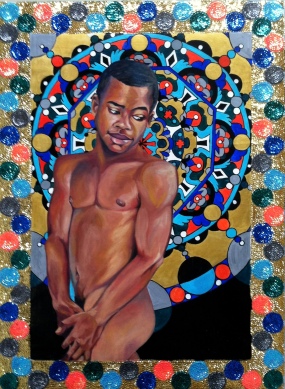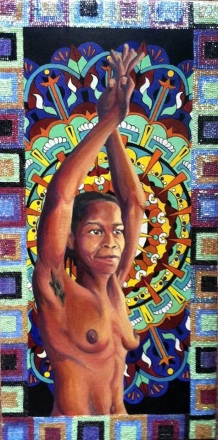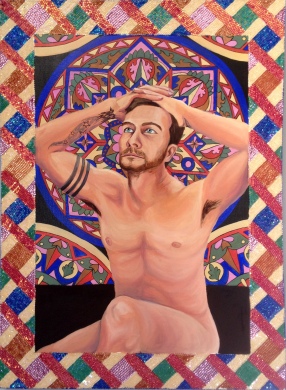Nudies, as my mom likes to call them, may seem like a strange subject matter for an artist like myself whose community work focuses on populations that are marginalized, impoverished, and traditionally exploited. So I wanted to take a moment to address the decision of mine to portray many of my subjects this way in my artwork.
To put it simply, I like to paint flesh more than fabric. I would rather paint what God has created rather than what man has fabricated. I find more beauty in that. I find more depth in that.
 Painting someone nude represents the person at their most genuine, authentic, raw, and vulnerable self. I think that that is the part of ourselves that is most important to portray through art. As soon as you cover someone up with clothing, the message includes something hidden, something untrue, something reserved. I believe that much of Art’s power lies in its ability to introduce us to the most authentic parts of humanity, to tell stories of people to others who would never hear their stories otherwise. The best way to do this, I feel, is without the obstruction of clothing.
Painting someone nude represents the person at their most genuine, authentic, raw, and vulnerable self. I think that that is the part of ourselves that is most important to portray through art. As soon as you cover someone up with clothing, the message includes something hidden, something untrue, something reserved. I believe that much of Art’s power lies in its ability to introduce us to the most authentic parts of humanity, to tell stories of people to others who would never hear their stories otherwise. The best way to do this, I feel, is without the obstruction of clothing.
My art is also about the human spirit. It’s about the soul, and the body in its most natural form can be seen as the vessel for each soul. By seeing a person nude and vulnerable and real, both the artist and the viewer are able to access the spirit in a way that would be impossible otherwise. Who we are, really are, is very different than who we allow the rest of the world to see. The character that we paint ourselves as when we put on clothing and go out into the world and about our lives, is never who we are at our most essential core. When the body is stripped of clothing the soul also becomes stripped of any artifice that pollutes or dilutes our identity.
A naked body does not make an image inappropriate or pornographic. Anyone who sees a naked body and immediately equates it with sex, needs to expand their understanding of what the body is. If you automatically view every naked body as erotic, the problem lies with you, not with the image itself. We as a society have objectified our own and others’ bodies to such an extent that it seems an almost impossible expectation to redefine them as anything more than machines designed for the thrashing together of genitalia. But it is important for us to ask the questions that dig beyond the objectification and begin to search for that new definition and I believe that art plays a vital role in presenting those questions into public debate.
 All of this, however true to me, could be said no matter who the models were that I painted. But the fact that my nudie models are also Haitian presents a whole extra layer of significance to why I choose to portray them as such. Hatians are a collective people that have a very complicated history with body image through a culture that makes it very difficult to truly believe in one’s beauty. They are an entire nation of people that descended from slaves. Their history of revolution has convinced them that they are brave, strong, and resilient, but not beautiful. Their ancestors were brought to the land that they live on as objects to be used, treated as less than human, and viewed as disposable tools. Though they reclaimed their freedom over two hundred years ago, that perception of inferiority still infects the psyche telling Haitians that white people are more beautiful and even among Haitians that lighter complexions and straighter, softer hair, is more desirable. These ideas have been substantiated through the work of missionaries and aid workers that through their efforts to help the Haitian people always communicate a broad message that anything Haitian needs changed, improved, developed, enlightened. These all tell the Haitians that they are less than, and that is what many Haitians still see when they look at an image of themselves. Most images of Haitians portrayed through the media and through nonprofit advertising paint Haitians as bodies to be pitied, helped, donated to. At worst, it’s poverty porn, and at best it’s inspiration porn. Either way, it’s porn.
All of this, however true to me, could be said no matter who the models were that I painted. But the fact that my nudie models are also Haitian presents a whole extra layer of significance to why I choose to portray them as such. Hatians are a collective people that have a very complicated history with body image through a culture that makes it very difficult to truly believe in one’s beauty. They are an entire nation of people that descended from slaves. Their history of revolution has convinced them that they are brave, strong, and resilient, but not beautiful. Their ancestors were brought to the land that they live on as objects to be used, treated as less than human, and viewed as disposable tools. Though they reclaimed their freedom over two hundred years ago, that perception of inferiority still infects the psyche telling Haitians that white people are more beautiful and even among Haitians that lighter complexions and straighter, softer hair, is more desirable. These ideas have been substantiated through the work of missionaries and aid workers that through their efforts to help the Haitian people always communicate a broad message that anything Haitian needs changed, improved, developed, enlightened. These all tell the Haitians that they are less than, and that is what many Haitians still see when they look at an image of themselves. Most images of Haitians portrayed through the media and through nonprofit advertising paint Haitians as bodies to be pitied, helped, donated to. At worst, it’s poverty porn, and at best it’s inspiration porn. Either way, it’s porn.
But to see the Haitian body simply as a beautiful vessel worthy of beholding in a work of art, I can’t be so pretentious as to call such an act revolutionary, but it is certainly counter-cultural. If I can use my art to help a Haitian believe that their body and their image deserves to be viewed with greater dignity and depth, then I’m giving them a chance to take greater ownership of their body and how it’s viewed. Even though I’m still the one creating the paintings, the models have made the choice to share their bodies in such a way and to tell their own stories through the images about their own spirit that resides within their body.
And yet, while I say all of this, I fully acknowledge that me, being a white, privileged, male, non-Haitian doing this work, still creates a certain level of discordance with the message. I know that Haitians do not need my white male voice to affirm their beauty or worth nor is it my job to present their body to the gaze of other white privileged viewers,so through my work I must continually also create space for Haitian voices to be heard. At the same time, I cannot change the race, gender, or privilege that I was born with, nor can I change the artistic vocation that I’ve been called to, nor will I apologize for embracing life in a culture and place not my own. But the rather unfortunate fact remains that because of that privilege, I have opportunities to share and exhibit my work in ways that a native Haitian would not and the message coming from my visual voice is received differently than it would be from someone who looked more like the subjects of my paintings.  It is because I am conscious of this dissidence that I also recently created a nude self-portrait in the same style of my Haitian models because I would never want to portray their bodies in any way that I would not want my own to be depicted. Showing my pasty white body alongside my Haitian models is an acknowledgment of my place in relationship to them and also of my belief that God resides within each of us and my art is about our daily effort to discover where that divine energy lives and connect it to that within others and the world. My whiteness also simply introduces another shade into the spectrum where Haitians like to distinguish between people who are “nwe,” really really black, and just “nwa,” normal black, all the way through the other shades of brown, red, yellow, and “grimel,” as light as you can get without being white, all of which are included in my art through my diverse group of models.
It is because I am conscious of this dissidence that I also recently created a nude self-portrait in the same style of my Haitian models because I would never want to portray their bodies in any way that I would not want my own to be depicted. Showing my pasty white body alongside my Haitian models is an acknowledgment of my place in relationship to them and also of my belief that God resides within each of us and my art is about our daily effort to discover where that divine energy lives and connect it to that within others and the world. My whiteness also simply introduces another shade into the spectrum where Haitians like to distinguish between people who are “nwe,” really really black, and just “nwa,” normal black, all the way through the other shades of brown, red, yellow, and “grimel,” as light as you can get without being white, all of which are included in my art through my diverse group of models.
This great diversity of color is actually what makes me love to paint Haitian skin, because I get to use almost every single pigment to create it from deep violet to ultramarine blue to scarlet to crimson to ochre and yellow and oranges and creams and pinks. It’s all in there. Some viewers may just see my models as “Haitian” or as “black” but each one of them is created by a different combination of hues and tones and from a technical standpoint that gives me life as an artist in the process of making each piece, but from a conceptual standpoint, it also speaks in a subtle way to what it means to be Haitian and what it means to be human. I think it speaks much more powerfully than a dyed shirt or pair of pants would.
Nude paintings may not be everyone’s cup of tea, but we must realize that we each have a nude body that is uniquely our own and each one is beautiful because of what it holds in the spirit. Through my art I will continue to paint as many as I can and hope that others can view them for the messages and stories they transmit rather than the uses that they can be exploited for.
And if anyone reading this wants to model for me and become part of the series, just get in touch.
Love this.
Two follow up questions– do you paint from live nudes, from photos of nudes, or from your imagination of what someone would look like nude? Just curious
Second- have you ever painted a nude of a person of size? Talk about vulnerability. Now, I am not volunteering (ha!) but I am in the middle of this journey towards health with a focus on both cleaner eating and fat acceptance as well as the reprogramming of my mind as to what constitutes beauty. You know I love your work. But I have noticed that all your paintings are of thin people. I get that most Haituans are thin, so it might just be coincidence.
LikeLike
Thanks for the comment Gwenn! 1) I work from photos. I would prefer to work from live models, but where I don’t have a private studio in Haiti to work from or electricity for consistent lighting, makes it easier to just use photos. But I do take actual photos of actual models to work from. And 2) I would love to have more diversity in size and shape of my models, just haven’t had any curvier friends of mine agree to pose for me yet. But I’m working on getting some body diversity.
LikeLike